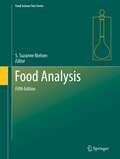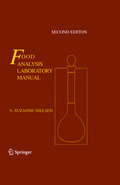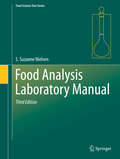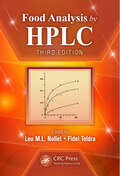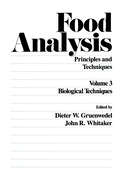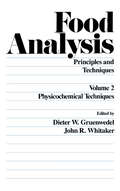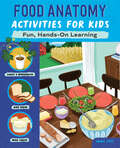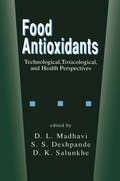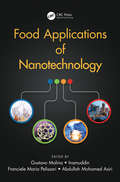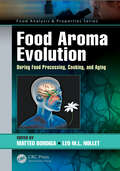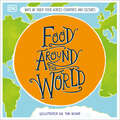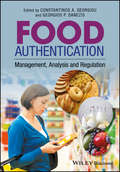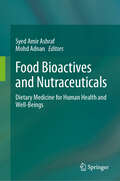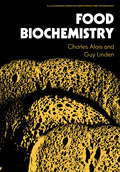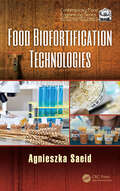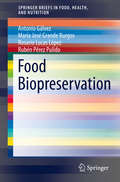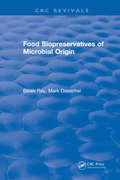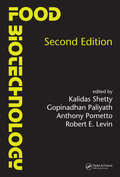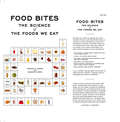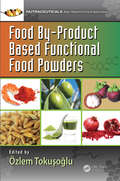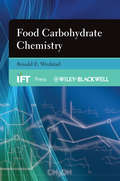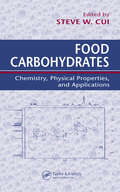- Table View
- List View
Food Analysis (Food Science Text Series)
by S. Suzanne NielsenThis fifth edition provides information on techniques needed to analyze foods for chemical and physical properties. The book is ideal for undergraduate courses in food analysis and is also an invaluable reference to professionals in the food industry. General information chapters on regulations, labeling, sampling, and data handling provide background information for chapters on specific methods to determine chemical composition and characteristics, physical properties, and objectionable matter and constituents. Methods of analysis covered include information on the basic principles, advantages, limitations, and applications. Sections on spectroscopy and chromatography along with chapters on techniques such as immunoassays, thermal analysis, and microscopy from the perspective of their use in food analysis have been expanded. Instructors who adopt the textbook can contact the editor for access to a website with related teaching materials.
Food Analysis Laboratory Manual
by S. Suzanne NielsenThis second edition laboratory manual was written to accompany Food Analysis, Fourth Edition, ISBN 978-1-4419-1477-4, by the same author. The 21 laboratory exercises in the manual cover 20 of the 32 chapters in the textbook. Many of the laboratory exercises have multiple sections to cover several methods of analysis for a particular food component of characteristic. Most of the laboratory exercises include the following: introduction, reading assignment, objective, principle of method, chemicals, reagents, precautions and waste disposal, supplies, equipment, procedure, data and calculations, questions, and references. This laboratory manual is ideal for the laboratory portion of undergraduate courses in food analysis.
Food Analysis Laboratory Manual (Food Science Text Series)
by S. Suzanne NielsenThis third edition laboratory manual was written to accompany Food Analysis, Fifth Edition, by the same author. New to this third edition of the laboratory manual are four introductory chapters that complement both the textbook chapters and the laboratory exercises. The 24 laboratory exercises in the manual cover 21 of the 35 chapters in the textbook. Many of the laboratory exercises have multiple sections to cover several methods of analysis for a particular food component of characteristic. Most of the laboratory exercises include the following: background, reading assignment, objective, principle of method, chemicals, reagents, precautions and waste disposal, supplies, equipment, procedure, data and calculations, questions, and references. This laboratory manual is ideal for the laboratory portion of undergraduate courses in food analysis.
Food Analysis by HPLC
by Fidel Toldrá Leo M.L. NolletFor food scientists, high-performance liquid chromatography (HPLC) is a powerful tool for product composition testing and assuring product quality. Since the last edition of this volume was published, great strides have been made in HPLC analysis techniques-with particular attention given to miniaturization, automatization, and green chemistry. Tho
Food Analysis: Principles and Techniques (In 4 Volumes)
by John R. Whitaker Dieter W. GruenwedelThis book describes a number of biological techniques that are of vital importance to the quality and safety assessment of foods, particularly in the areas of nutrition and food toxicology. It contains examples of the application of the principles in the analysis of compounds of interest in foods.
Food Analysis: Principles and Techniques (In 4 Volumes)
by GruenwedelWith advances in techniques and technology coupled with the growing need to deal withthe problems associated with quality assurance, product development, and food safety,the science of food analysis has developed rapidly in recent years. Food Analysis: Principlesand Techniques provides an unparalleled source of information for all aspects of thisfield, filling your needs for up-to-date, detailed treatment of the methods of food analysis.Volume 2 of this important 8-volume treatise focuses on essential physicochemical techniques,ranging from the measurement of physical parameters, such as temperature, solubility,and viscosity, to the determination of food components at the supramolecular andatomic levels. Incorporating the latest developments in instrumentation that facilitate rapid,quantitative analysis, Physicochemical Techniques assures you comprehensive, accuratecoverage that you can turn to time and time again.Consolidating the expertise of renowned international authorities, Food Analysis: Principlesand Techniques serves as the complete, state-of-the-art reference and the basis forcontinuing development. For all food analysts in industry, government, and academiaincludingfood scientists, chemists, biochemists, nutritionists, environmental chemists,and microbiologists-this major resource will be the standard by which other works arecompared . Also, graduate students in food science and nutrition will find each volume ofthis work indispensable in their studies.
Food Anatomy Activities for Kids: Fun, Hands-On Learning (Anatomy Activities for Kids)
by Amber K. StottA hands-on guide to the world of food science for kids ages 8 to 12 The meal on your plate has had many adventures on its way to your belly! Uncover the mysteries of the food you eat with Food Anatomy Activities for Kids, a kids' guide to the incredible history, science, and culture of food. It's packed with easy-to-understand lessons, fun recipes, and engaging experiments to make you feel connected to the food you eat—and make your mouth happy! Travel on a food journey around the world, taste new things, and learn fun facts. Find out all about foods that are foraged or farmed, sweet or savory, baked or preserved—and don't forget foods that you drink! Get involved by predicting the answers to questions, testing your ideas, and drawing conclusions just like a real food scientist. Inside Food Anatomy Activities for Kids, you'll: Follow the life of food—Discover colorfully illustrated lessons on the history and uses of 20 different types of foods. Try awesome activities—Dive into cool experiments like preserving egg yolks with salt, making butter in a mason jar, and growing new fruit from leftover seeds. Think like a scientist—Grab your own notebook and write down your discoveries with the help of in-depth journal prompts after every activity. Take a trip through the wonderful world of food with Food Anatomy Activities for Kids!
Food Antioxidants: Technological: Toxicological and Health Perspectives
by S.S. Deshpande D.L. Madhavi D.K. Salunkhe"Offers comprehensive coverage of the latest toxicological, technological, and nutritional developments in both natural and synthetic antioxidants used in the food industry. Explores the sources of antioxidants, antioxidant classification, synergism, degradation in food systems, and techniques for identification."
Food Applications of Nanotechnology
by Gustavo Molina Inamuddin Franciele Maria Pelissari Abdullah Mohamed AsiriNanotechnology has developed remarkably in recent years and, applied in the food industry, has allowed new industrial advances, the improvement of conventional technologies, and the commercialization of products with new features and functionalities. This progress offers the potential to increase productivity for producers, food security for consumers and economic growth for industries. Food Applications of Nanotechnology presents the main advances of nanotechnology for food industry development. The fundamental concepts of the technique are presented, followed by examples of application in several sectors, such as the enhancement of flavor, color and sensory characteristics; the description of the general concepts of nano-supplements, antimicrobial nanoparticles and other active compounds into food; and developments in the field of packaging, among others. In addition, this work updates readers on the industrial development and the main regulatory aspects for the safety and commercialization of nanofoods. Features: Provides a general overview of nanotechnology in the food industry Discusses the current status of the production and use of nanomaterials as food additives Covers the technological developments in the areas of flavor, color and sensory characteristics of food and food additives Reviews nanosupplements and how they provide improvements in nutritional functionality Explains the antibacterial properties of nanoparticles for food applications This book will serve food scientists and technologists, food engineers, chemists and innovators working in food or ingredient research and new product development. Gustavo Molina is associate professor at the UFVJM (Diamantina—Brazil) in Food Engineering and head of the Laboratory of Food Biotechnology and conducts scientific and technical research. His research interests are focused on industrial biotechnology. Dr. Inamuddin is currently working as assistant professor in the chemistry department of Faculty of Science, King Abdulaziz University, Jeddah, Saudi Arabia. He is also a permanent faculty member (assistant professor) at the Department of Applied Chemistry, Aligarh Muslim University, Aligarh, India. He has extensive research experience in multidisciplinary fields of analytical chemistry, materials chemistry, and electrochemistry and, more specifically, renewable energy and environment. Prof. Abdullah M. Asiri is professor of organic photochemistry and has been the head of the chemistry department at King Abdulaziz University since October 2009, as well as the director of the Center of Excellence for Advanced Materials Research (CEAMR) since 2010. His research interest covers color chemistry, synthesis of novel photochromic and thermochromic systems, synthesis of novel coloring matters and dyeing of textiles, materials chemistry, nanochemistry and nanotechnology, polymers, and plastics. Franciele Maria Pelissari graduated in Food Engineering; earned her master’s degree (2009) at the University of Londrina (UEL), Londrina, Brazil; and her PhD (2013) at the University of Campinas (Unicamp), Campinas, Brazil. Since 2013, she has been associate professor at the Institute of Science and Technology program at the Federal University of Jequitinhonha and Mucuri (UFVJM), Diamantina, Brazil, in Food Engineering, and also full professor in the graduate program in Food Science and Technology.
Food Aroma Evolution: During Food Processing, Cooking, and Aging (Food Analysis & Properties)
by Matteo Bordiga, Leo M.L. NolletOf the five senses, smell is the most direct and food aromas are the key drivers of our flavor experience. They are crucial for the synergy of food and drinks. Up to 80% of what we call taste is actually aroma. Food Aroma Evolution: During Food Processing, Cooking, and Aging focuses on the description of the aroma evolution in several food matrices. Not only cooking, but also processing (such as fermentation) and aging are responsible for food aroma evolution. A comprehensive evaluation of foods requires that analytical techniques keep pace with the available technology. As a result, a major objective in the chemistry of food aroma is concerned with the application and continual development of analytical methods. This particularly important aspect is discussed in depth in a dedicated section of the book. Features Covers aromatic evolution of food as it is affected by treatment Focuses on food processing, cooking, and aging Describes both classic and new analytical techniques Explains how the flavor perception results are influenced by other food constituents The book comprises a good mix of referenced research with practical applications, also reporting case studies of these various applications of novel technologies. This text represents a comprehensive reference book for students, educators, researchers, food processors, and food industry personnel providing an up-to-date insight. The range of techniques and materials covered provides engineers and scientists working in the food industry with a valuable resource for their work. Also available in the Food Analysis & Properties Series: Ambient Mass Spectroscopy Techniques in Food and the Environment, edited by Leo M.L. Nollet and Basil K. Munjanja (ISBN: 9781138505568) Hyperspectral Imaging Analysis and Applications for Food Quality, edited by N.C. Basantia, Leo M.L. Nollet, and Mohammed Kamruzzaman (ISBN: 9781138630796) Fingerprinting Techniques in Food Authentication and Traceability, edited by Khwaja Salahuddin Siddiqi and Leo M.L. Nollet (ISBN: 9781138197671) For a complete list of books in this series, please visit our website at: www.crcpress.com/Food-Analysis--Properties/book-series/CRCFOODANPRO
Food Around the World (DK Around the World)
by DKIntroduce young readers to a variety of countries and cultures through an exploration of food.Discover fascinating facts about the food on your plate and tasty dishes from all around the world in this educational reader to help children aged 7-9 learn about countries and cultures.Children can explore the significance of food to different cultures and the variety of ways in which food is prepared and shared. Then learn how diet can vary according to personal choice, culture, and medical needs, and how food can be broken down into groups to help us maintain a healthy, balanced diet.The educational series can help children learn about the world, with:Links to key social studies and geography curriculum objectives. Content that allows children to learn about a variety of countries, cultures, and celebrations through food and its significance to each country and culture.Recipes featured that are simple and easy to follow for young readers to try out. Food Around the World follows the journey of food from farm to table, learning how seasons can affect what produce is available. Children can learn how food is packaged, and how to recycle packaging and reduce food waste. Plus, fun food facts show how food can be grown to extremes! About the seriesThis book is part of the …Around the World series, which includes Celebrations Around the World and Language Around the World. The series is designed to inspire and inform children with bright and original illustrations and fascinating facts about the world around us.
Food Authentication: Management, Analysis and Regulation
by Constantinos A. Georgiou Georgios P. DanezisThe determination of food authenticity is a vital component of quality control. Its importance has been highlighted in recent years by high-profile cases in the global supply chain such as the European horsemeat scandal and the Chinese melamine scandal which led to six fatalities and the hospitalisation of thousands of infants. As well as being a safety concern, authenticity is also a quality criterion for food and food ingredients. Consumers and retailers demand that the products they purchase and sell are what they purport to be. This book covers the most advanced techniques used for the authentication of a vast number of products around the world. The reader will be informed about the latest pertinent analytical techniques. Chapters focus on the novel techniques & markers that have emerged in recent years. An introductory section presents the concepts of food authentication while the second section examines in detail the analytical techniques for the detection of fraud relating to geographical, botanical, species and processing origin and production methods of food materials and ingredients. Finally, the third section looks at consumer attitudes towards food authenticity, the application of bioinformatics to this field, and the Editor’s conclusions and future outlook. Beyond being a reference to researchers working in food authentication it will serve as an essential source to analytical scientists interested in the field and food scientists to appreciate analytical approaches. This book will be a companion to under- and postgraduate students in their wander in food authentication and aims to be useful to researchers in universities and research institutions.
Food Bioactives
by Munish PuriThis book focuses on various types of bioactive compounds, including secondary metabolites, oligosaccharides, polysaccharides, flavonoids, peptides/proteins, carotenoid pigments, quinones, terpenes, and polyunsaturated fatty acids, and presents an overview of their nutraceutical activities. It covers the current status and future potential of food compounds, as well as extraction technologies for bioactives derived from plant, fungi and marine-derived bioactive agents. Finally, health-promoting effects of plant, fungi and marine-derived bioactive agents are discussed. Chapters come from top researchers in this area from around the globe. The volume caters to the needs of undergraduate and post-graduate students in the area of food biotechnology, food bioprocessing, biotechnology, food engineering, etc. , and also contains information pertinent to researchers.
Food Bioactives and Health (Food Bioactive Ingredients Ser.)
by Charis M. GalanakisBioactive natural compounds have gained attention in recent years due to their potential health benefits, including reducing the risk of diabetes, cancer, and cardiovascular diseases. These benefits derive from bioactive compounds' anti-tumor, anti-inflammatory, anti-oxidative, anti-hypertensive and anti-hyperlipidemic activities, which serve in addition to their basic nutritional functions. Over the last decade, researchers have investigated the health impact of bioactive compounds in detail, and the development of food applications has attracted great interest. Consumer demand has surged for functional foods (nutraceuticals), superfoods, and tailor-made foods, generated by supplementing traditional food products with bioactive ingredients. Food Bioactives and Health offers comprehensive coverage of the properties and health effects of food bioactives in view of new trends in processing, food science and food technology. Starting with the metabolic characteristics of polyphenols, glucosinolates, and other food bioactives, the text then dives into their impact on human health and recent applications in the world of food technology. For food scientists, food technologists, and product developers looking to understand the role of food bioactives in health and develop applications in personalized nutrition, functional foods and nutraceuticals, Food Bioactives and Health serves as a one-stop reference.
Food Bioactives and Nutraceuticals: Dietary Medicine for Human Health and Well-Beings
by Mohd Adnan Syed Amir AshrafThis book examines nutraceuticals derived from plant, animal, or microbial sources, and presenting significant opportunities for food scientists and industry professionals to develop innovative foods or food components that address future human wellness and well-being requirements. These nutraceuticals can be specifically identified as antioxidants, dietary fiber, prebiotics, polyunsaturated fatty acids, probiotics, vitamins, polyphenols, and spices. The book also intends to consolidate current research and reviews on bioactive components inherent in traditional foods, highlighting their nutraceutical significance for promoting a healthy lifestyle. Moreover, it elaborates on the potential therapeutic applications of food bioactives as next-generation nutraceuticals sourced from novel origins. Emphasis is placed on various aspects of food bioactive compounds, exploring their prospective roles in the formulation of nutraceuticals aimed at enhancing human health and wellness, while also evaluating their potential in the management and prevention of metabolic disorders. Furthermore, the volume acknowledges the clinical implications of nutraceuticals, including their prospective applications within the food and pharmaceutical industries.
Food Biochemistry (Ellis Horwood Series in Food Science and Technology)
by Charles AlaisWhat I have said will go to prove that true science is the, one which teaches us to increase our satisfaction by drawing out the best from nature's productions. M. Henri Braconnot Nancy, 4th April 1830 (Extract from the Note on Casein and Milk, Annales de Chimie et de Physique (1830) 43, 351.) The main objective of this work is to provide a biochemical approach for students of food science and technology. It may also be useful to biologists generally and to biochemists in particular in providing a source of reference to help resolve some of their problems. Finally, professionals in the food industry will find here detailed information on aspects of biotechnology. With the continuing development of teaching in this field in the mainstream courses of Instituts Universitaires de Technologiet, Universities and Grandes Ecoles:j: in France, the need for an Abn?ge (Essential Guide) has become urgent. Students have to refer to various specialist works, which are considerable in number, expensive and often out of date. The authors were faced with the task of selecting material and presenting it in such a way that the finished book would be reduced to a size in keeping with the spirit of the Abrege collection.
Food Biofortification Technologies (Contemporary Food Engineering)
by Agnieszka SaeidBiofortification, which can be defined as the process of increasing the content/density of essential nutrients and/or its bioavailability of food with valuable compounds, is a promising means of increasing nutrient intakes. Traditional fortification practices in which exogenous nutrients are added to food can increase the content of nutrients but the use of biofortified foods with nutrients also may deliver the compounds in a more available form, as well as boost the overall relative effectiveness of these foods in raising nutrients status. Food Biofortification Technologies presents the state of the art in the field of novel methods of fortification and agricultural treatments as a way to improve the quality of obtained food products or compounds enriched with valuable nutrients. The book deals with fortification methods and agricultural treatments, which can improve the quality of food products or other agricultural compounds, providing them with a higher density of valuable nutrients. The utilization of novel products, such as feed additives and fertilizers, can avert nutrients depletion in food products. The book describes new and conventional methods of introducing valuable compounds into food components and presents the application of biosorption, bioaccumulation, and utilization of fertilizers in obtaining designer food. Attention is paid to the use of biomass as the carrier of nutrients such as microelements into the food components. The chapters are dedicated to specific food products and their nutrient components. The first chapter discusses the agronomic biofortification with micronutrients where the fertilization strategies are pointed out as a key to plant/cereals fortification. Other chapters present the fortification of animal foodstuffs such as meat, fish, milk, and eggs as well as the fortification of plant foodstuffs such as vegetables, fruits, and cereals. The book also explores advances in food fortification with vitamins and co-vitamins, essential minerals, essential fatty and amino acids, phytonutrients, and enzymes.
Food Biopreservation
by Antonio Galvez María José Grande Burgos Rosario Lucas López Rubén Pérez PulidoThe purpose of this Brief is to provide a global view of the concept of biopreservation and its potential and existing applications in the different food sectors. Biopreservation, an approach already experimented with by our ancestors, has been used empirically for centuries and now the rationale behind it is becoming increasingly popular, applied singly or in combination with novel and classical food processing technologies. The growing world population, together with the globalization of the food market and consumer demand for foods that are ready to eat, lightly preserved, fresh-tasting, and rich in flavor, nutrients, and bioactive compounds, is forcing the food industry to develop less aggressive food preservation methods.
Food Biopreservatives of Microbial Origin
by Bibek RayFood Biopreservatives of Microbial Origin provides basic and applied information regarding how antimicrobial metabolites of safe, food-grade bacteria (used in food fermentation) can be utilized as food preservatives. The authors discuss why biopreservation of food is important, identify the foods and microoganisms for which biopreservation is suitable, and explore the potential of bacteriocins of food-grade starter culture bacteria and the antimicrobial proteins of yeasts as possible food biopreservatives. The book is a valuable reference resource that will benefit students of food science and researchers in food industries, regulatory agencies, and advisory groups.
Food Biotechnology (Food Science and Technology)
by Kalidas Shetty Gopinadhan Paliyath Robert E. Levin Anthony PomettoRevised and updated to reflect the latest research and advances available, Food Biotechnology, Second Edition demonstrates the effect that biotechnology has on food production and processing. It is an authoritative and exhaustive compilation that discusses the bioconversion of raw food materials to processed products, the improvement of food
Food Bites
by Richard W Hartel Annakate HartelFood Bites is an easy-to-read, often humorous book on the scientific basis of the foods we eat, and answers those pesky, niggling questions such as: Is the quality of beer really affected by the type of water used? and Processed foods: good or bad? Readers will be captivated by this superbly written book, especially so as their guides are Professor Richard Hartel, professor of Food Engineering at UW-Madison, along with his daughter, AnnaKate Hartel. Professor Hartel has for the last four years penned a witty and illuminating column on all aspects of food science for the Capital Times of Madison, and his weekly wisdom has now been collected into a single publication. With a huge and growing interest in the science of food, this treasure trove of knowledge and practical information, in 60 bite-sized chunks, is sure to be a bestseller.
Food By-Product Based Functional Food Powders (Nutraceuticals)
by Lu O 287 Özlem Toku 351The by-products of food processing operations may still contain many valuable substances. Nowadays, the potential utilization of these major components has been the focus of increasing attention. Food by-products or food industry shelf-stable coproducts in liquid, pomace, or powder forms can be obtained by processing fruits, vegetables, meat, seafood, milk and dairy, cereal, nuts, fats, and oils; drying by-products and converting them into powder offers a way to preserve them as useful and valuable products. Food By-product Based Functional Food Powders discusses food powders derived from food by-products and waste as well as their chemical characterization, functional properties, unique bioactive features, enhancing technologies, processing of food by-product powders, and utilization. The book discusses how these by-products may be evaluated as a source of dietary phytochemicals including phenolic antioxidants, carotenoids, other bioactive polyphenols, and dietary fiber; as a source of proteins, peptides, and amino acids; as extruded products; as a source of collagen and gelatin; and as a source of various food additive materials.
Food Carbohydrate Chemistry: Water, Proteins, Enzymes, Lipids, And Carbohydrates (Institute of Food Technologists Series #48)
by Ronald E. WrolstadNot since "Sugar Chemistry" by Shallenberger and Birch (1975) has a text clearly presented and applied basic carbohydrate chemistry to the quality attributes and functional properties of foods. Now in Food Carbohydrate Chemistry, author Wrolstad emphasizes the application of carbohydrate chemistry to understanding the chemistry, physical and functional properties of food carbohydrates. Structure and nomenclature of sugars and sugar derivatives are covered, focusing on those derivatives that exist naturally in foods or are used as food additives. Chemical reactions emphasize those that have an impact on food quality and occur under processing and storage conditions. Coverage includes: how chemical and physical properties of sugars and polysaccharides affect the functional properties of foods; taste properties and non-enzymic browning reactions; the nutritional roles of carbohydrates from a food chemist's perspective; basic principles, advantages, and limitations of selected carbohydrate analytical methods. An appendix includes descriptions of proven laboratory exercises and demonstrations. Applications are emphasized, and anecdotal examples and case studies are presented. Laboratory units, homework exercises, and lecture demonstrations are included in the appendix. In addition to a complete list of cited references, a listing of key references is included with brief annotations describing their important features. Students and professionals alike will benefit from this latest addition to the IFT Press book series. In Food Carbohydrate Chemistry, upper undergraduate and graduate students will find a clear explanation of how basic principles of carbohydrate chemistry can account for and predict functional properties such as sweetness, browning potential, and solubility properties. Professionals working in product development and technical sales will value Food Carbohydrate Chemistry as a needed resource to help them understand the functionality of carbohydrate ingredients. And persons in research and quality assurance will rely upon Food Carbohydrate Chemistry for understanding the principles of carbohydrate analytical methods and the physical and chemical properties of sugars and polysaccharides.
Food Carbohydrates: Chemistry, Physical Properties, and Applications
by Steve W. CuiUnique in its broad range of coverage, Food Carbohydrates: Chemistry, Physical Properties and Applications is a comprehensive, single-source reference on the science of food carbohydrates. This text goes beyond explaining the basics of food carbohydrates by emphasizing principles and techniques and their practical application in quality control, pr
Food Carotenoids
by Delia B. Rodriguez-AmayaCarotenoids were first studied as natural pigments, then as precursors of vitamin A, and then as bioactive compounds against chronic diseases. These compounds have been and continue to be the subject of intense research worldwide, now with an expanded scope. Food Carotenoids: Chemistry, Biology and Technology gathers all the important information about these major compounds which impact both food quality and human health. It integrates in one volume various aspects of food carotenoids, such as: Structures and physicochemical properties Biosynthetic pathways and metabolism Analysis and composition of foods Stability and reactions during processing Commercial production as food colorants and precursors of aroma compounds Bioavailability and health benefits Having worked with carotenoids in various aspects for 44 years, Delia Rodriguez-Amaya is uniquely placed to pass on her wealth of knowledge in this field. This book will serve as solid background information for professionals in Food Science, Food Technology, Nutrition, Agriculture, Biology, Chemistry and Medical Sciences, whether in the academe, industry, governmental and non-governmental agencies.
